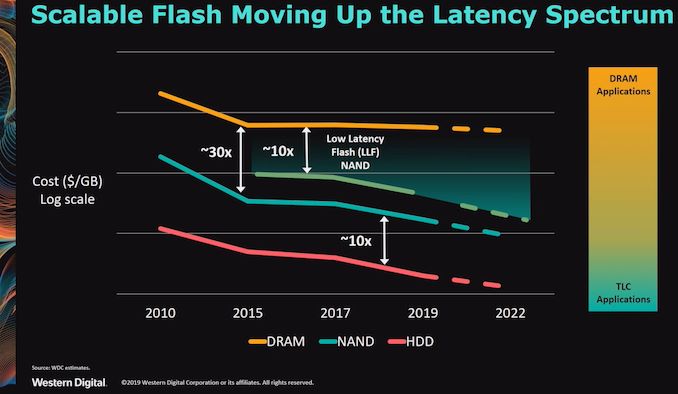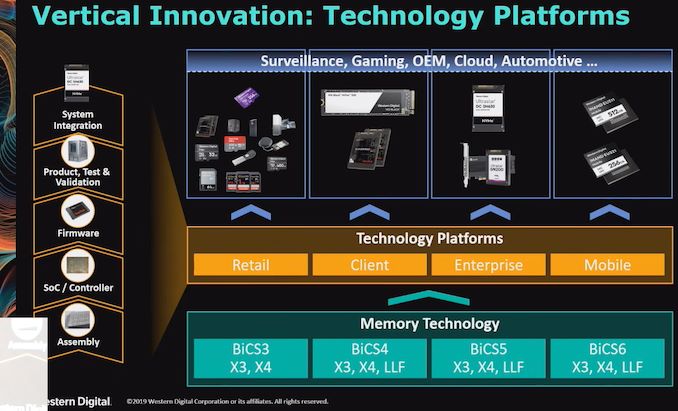Western Digital Develops Low-Latency Flash to Compete with Intel Optane
by Anton Shilov on March 12, 2019 12:00 PM EST
Western Digital is working on its own low-latency flash memory that will offer a higher performance and endurance when compared to conventional 3D NAND, ultimately designed to compete against Optane storage.
At Storage Field Day this week, Western Digital spoke about its new Low Latency Flash NAND. The technology is meant to fit somewhere between 3D NAND and DRAM, similar to Intel's Optane storage and Samsung's Z-NAND. Similar to those technologies, according to Western Digital, its LLF memory will feature access time “in the microsecond range”, using 1 bit-per-cell and 2 bit-per-cell architectures.
The manufacturer admits that its LLF is a customized device that is very fast because it is tailored for performance. The memory will cost 10 times less than DRAM, but 20 times more than 3D NAND (at least based on today’s estimates) in terms of per-GB prices, so it will likely be used only by select applications aimed at datacenters or high-end workstations, similar to where Optane and Z-NAND is today.
Western Digital does not disclose all the details regarding its low-latency flash memory and it is impossible to say whether it has anything to do with Toshiba’s XL-Flash low-latency 3D NAND introduced last year as well as other specialized types of flash. Quite naturally, the company is also reluctant to talk about actual products based on its LLF memory, or when are they set to become available. Meanwhile, Western Digital’s LLF belongs to the BICS4 generation of 3D NAND memory and can therefore be produced even today.
While Western Digital’s low-latency flash will compete against Intel’s Optane and Samsung’s Z-NAND SSDs, the company does not call LLF as a Storage Class Memory (SCM).
In the more long term, Western Digital is working on ReRAM-based SCM internally, and on memristor-based SCM with HP. Keeping in mind that research and development cycles take many years, it looks like the company will address applications that require capacity and performance with a more familiar NAND flash before adopting next-gen technologies.
Related Reading
- Toshiba Announces XL-Flash Low-Latency 3D NAND
- Western Digital to Use 3D ReRAM as Storage Class Memory for Special-Purpose SSDs
- Microsemi Licenses Crossbar ReRAM Non-Volatile Memory
- New Generation of Optane M.2 SSDs Coming Soon
- Intel's Response: Micron’s Control of 3D XPoint Fab Will Not Disrupt Optane Roadmap
Source: Western Digital at Storage Field Day (via Blocks & Files)













22 Comments
View All Comments
Bigos - Tuesday, March 12, 2019 - link
"The memory will cost 10 times less than DRAM, but 20 times more than 3D NAND"That's 3 times more than 3D NAND, not 20 times.
FreckledTrout - Tuesday, March 12, 2019 - link
Agree. The 10x cost of LLF Nand multiplied by 3 = 30x of 3d Nand.PeachNCream - Tuesday, March 12, 2019 - link
"...using 1 bit-per-cell and 2 bit-per-cell architectures."That sounds suspiciously like SLC and MLC. Hmmmm....
Samus - Tuesday, March 12, 2019 - link
The less the voltage states, naturally the lower the latency. But not on the level of Optane which was built from the ground up for low latency. Optane is more like static DRAM whereas this and Samsung Z-NAND are highly optimized NAND.p1esk - Tuesday, March 12, 2019 - link
There's no such thing as "static DRAM" :)FunBunny2 - Tuesday, March 12, 2019 - link
" There's no such thing as "static DRAM" :) "sure there is. what is labeled SRAM is, in fact, refresh required DRAM, just more complicated and faster. true SRAM is made with true flip-flops and doesn't require refresh. I don't even know whether anyone even makes it any longer.
p1esk - Tuesday, March 12, 2019 - link
You are confused. SRAM and DRAM are completely different technologies. SRAM uses transistors which can hold state as long as power is supplied to the chip. SRAM is present in every modern CPU in the form of caches. DRAM uses capacitors which leak charge and must be refreshed periodically. There's no such thing as "static DRAM", because DRAM by definition is "dynamic", as in "not static". I suggest Wikipedia for more info.Samus - Tuesday, March 12, 2019 - link
There is "static" DRAM: X-Point :PThere is no escaping the similarities in architecture between X-Point and RAM, not withstanding the fundamental difference in architecture allowing X-Point to hold a cell state without power not unlike NAND.
But alas, I should have put static in quotations or just said alternatives to MRAM, TRAM, etc. Everyone is taking their own approach to scaling up NVRAM.
Dr. Swag - Thursday, March 14, 2019 - link
Yeah, they're similar in that they both use small things to store data... AFAIK optane is pretty different and seems to be a sort of rram, which is quite different from dramshabby - Tuesday, March 12, 2019 - link
Wd is going back... back to the future!